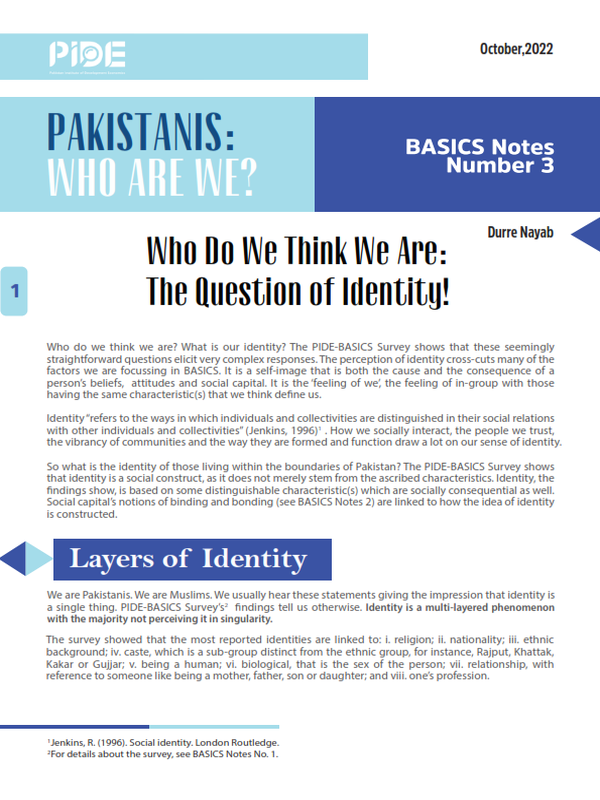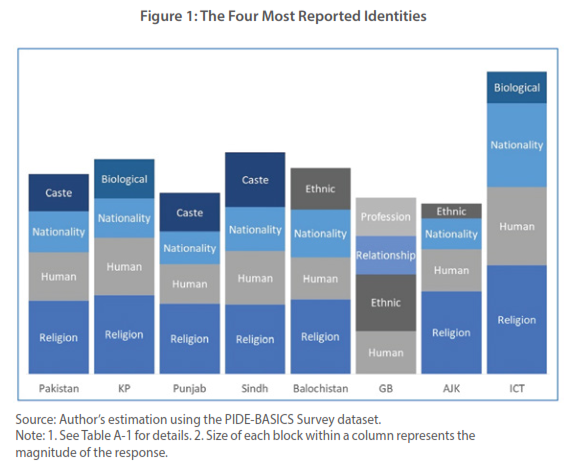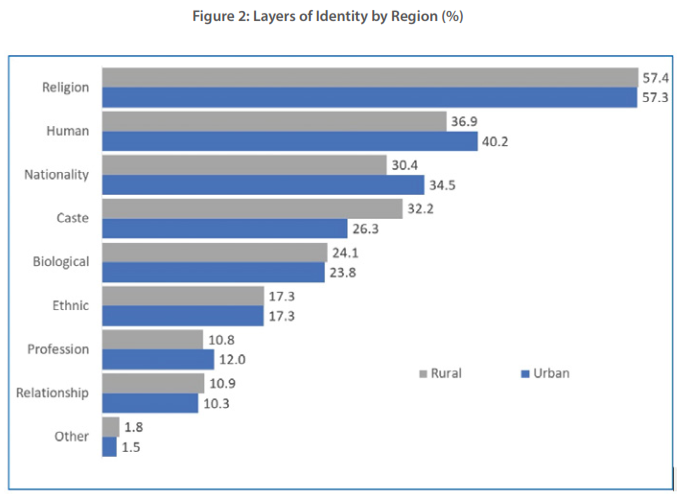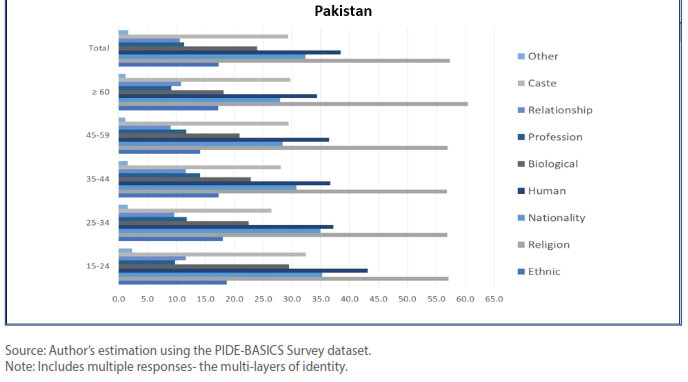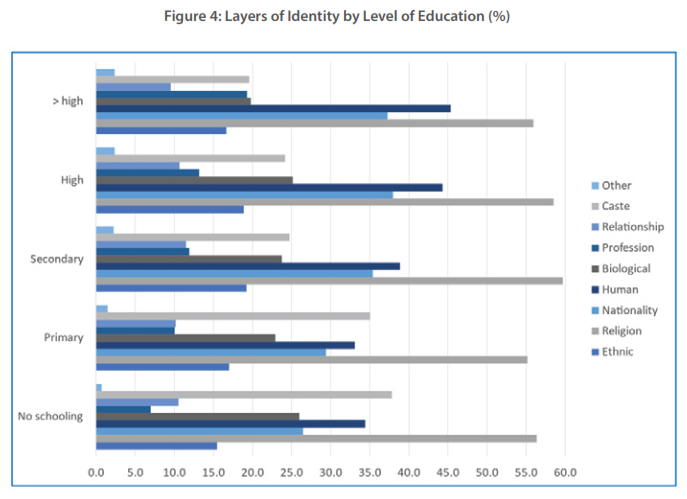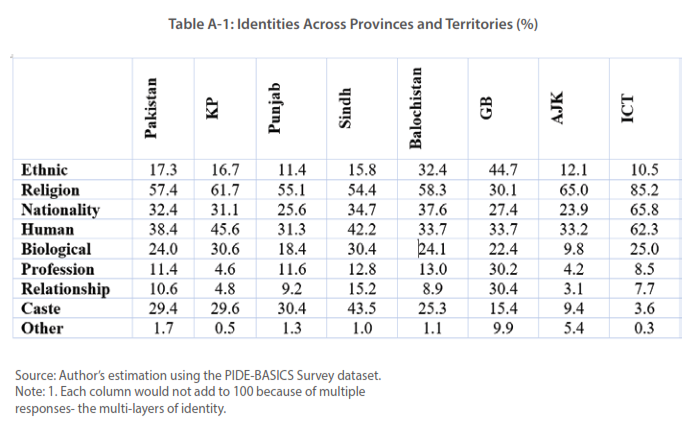Who Do We Think We Are The Question of Identity!
Who do we think we are? What is our identity? The PIDE-BASICS Survey shows that these seemingly straightforward questions elicit very complex responses. The perception of identity cross-cuts many of the factors we are focussing in BASICS. It is a self-image that is both the cause and the consequence of a person’s beliefs, attitudes and social capital. It is the ‘feeling of we’, the feeling of in-group with those having the same characteristic(s) that we think define us.
Identity “refers to the ways in which individuals and collectivities are distinguished in their social relations with other individuals and collectivities” (Jenkins, 1996)[1]. How we socially interact, the people we trust, the vibrancy of communities and the way they are formed and function draw a lot on our sense of identity.
So what is the identity of those living within the boundaries of Pakistan? The PIDE-BASICS Survey shows that identity is a social construct, as it does not merely stem from the ascribed characteristics. Identity, the findings show, is based on some distinguishable characteristic(s) which are socially consequential as well. Social capital’s notions of binding and bonding (see BASICS Notes 2) are linked to how the idea of identity is constructed.
Layers of Identity
We are Pakistanis. We are Muslims. We usually hear these statements giving the impression that identity is a single thing. PIDE-BASICS Survey’s[2] findings tell us otherwise. Identity is a multi-layered phenomenon with the majority not perceiving it in singularity.
The survey showed that the most reported identities are linked to: i. religion; ii. nationality; iii. ethnic background; iv. caste, which is a sub-group distinct from the ethnic group, for instance, Rajput, Khattak, Kakar or Gujjar; v. being a human; vi. biological, that is the sex of the person; vii. relationship, with reference to someone like being a mother, father, son or daughter; and viii. one’s profession.
________
[1]Jenkins, R. (1996). Social identity. London Routledge.
[2]For details about the survey, see BASICS Notes No. 1.
________
Table 1 shows that the majority of the population has a multi-layered identity, ranging from 76% in GB to 44.5% in AJK. It is worth noting that the trends shown in urban and rural Pakistan are not very different (see Table 1). Among the four provinces, the population of Punjab has the biggest proportion that has a specific, single identity, with just half the population (50.6%) having a multi-layered identity. Among the regions, Islamabad Capital Territory (ICT) has the biggest proportion of the population with a multi-layered identity (89%), as can be seen in Table 1.
Looking at those who report a specific identity, it is not surprising to see religious identity be the most common one, at both national and regional levels (see Table 1). Among provinces and territories, single religious identity is strongest in Punjab (16.7%) and AJK (28.3%), respectively. People of GB report the lowest single religious identity (1.3%).
National identity, that of being a Pakistani, as the single identity is not a strong one nationally, regionally or across provinces and territories (Table 1). Being a human is an identity kept by some, but many more give importance to caste as their single identity. It was a rather surprising finding that more than ethnicity it was caste, a narrower ascribed characteristic, that was considered more important by the people of Pakistan. Mainly two provinces push this rate up, namely Punjab and Sindh (Table 1).
Identities
The above discussion shows that a singular identity, whatever that may be, is not a reality for the majority of the people in Pakistan. Let us now see the various identities maintained by the populace.
Identity by Province and Territories
Looking at the national level, religion is part of the multi-layered personal identity for the majority (57.4%), as can be seen from Table A-1. Identity of being a human (38.4%), a Pakistani (32.4%) and belonging to a particular caste (29.4%) follow in that sequence.
If we look at the most reported identities, the four provinces and the three territories show a lot of variation in the type of identities and their respective prevalence. If we pick the four most reported identities across the seven geographical boundaries, the trend appears as shown in Figure 1. We see that:
- Being a human is an identity maintained by a substantial population across the whole country.
- Religious identity is a strong one, except for in GB where it is not among the top four identities.
- National identity is prevalent, with varying intensity, across Pakistan. Among the four provinces, the largest proportion is in Balochistan which considers being a Pakistani as part of their identity, followed by Sindh and KP. The population of Punjab has the smallest proportion including nationality as a layer of their identity.
- While ethnicity is an important part of identity in Balochistan, GB and AJK, it is caste in Sindh and Punjab.
- Being a male or female, is a major layer of identity in KP and ICT.
- GB has the most distinct pattern, with profession and relationship featuring among the major identities.
- ICT exhibits a strong multiplicity of identities.
Identities by Region
Contrary to the common belief, rural and urban Pakistan show very similar trends in how the population perceive their identity (see Figure 2). Nationality and caste are the two identities that show some level of difference, with the prior higher in urban and the latter more prevalent in rural areas.
Source: Author’s estimation using the PIDE-BASICS Survey dataset.
Note: Includes multiple responses- the multi-layers of identity.
Identity by Age-Sex
Age and sex define trends like no other demographic variable, and the same is true when we look into identities as well. Figure 3 shows the many layers of identity that the males and females of the country have at different ages. We see the following trends:
- Multiplicity of identities reduces with age
- Females have fewer layers of identity than males
- Religious identity is stronger in males than females
- National identity is maintained much more strongly in males than females, and by younger population than the older. The same trend is shown for those who consider being a human as part of their identity
- Caste as an identity reduces with age for males and increases for females.
- Relationship as a source of identity is more frequent for females than males across all ages.
Identity by Education
Does education change the way people conceptualise their identity? Figure 4 shows the multi-layers of identity maintained by the people of Pakistan by education, and we see that:
- Religion and ethnicity as layers of identity remain almost the same across educational levels.
- Being a Pakistani (nationality) as an identity increases with increasing education.
- Increasing educational level shows an increasing proportion taking ‘being a human’ as a source of identity, as does profession.
- Caste as a layer of identity shrinks with increasing education.
Source: Author’s estimation using the PIDE-BASICS Survey dataset.
Note: Includes multiple responses- the multi-layers of identity.
Identity by Income
Lastly, we look into how identity varies with the income level of the household (see Figure 5). PIDE-BASICS survey shows that there are no major differences across the income quintiles, but the trends show that:
- Religious identity matters the least for the bottom income quintile.
- Nationality as an identity increases with improving income level.
- Caste as a source of identity is strongest for the lowest quintile, getting weaker with higher quintiles.
- Identity drawn from profession and being a human goes up, and that based on relationship goes down as we go up the income ladder.
- Identity stemming from biology is the strongest for the middle quintile.
Source: Author’s estimation using the PIDE-BASICS Survey dataset.
Note: Includes multiple responses- the multi-layers of identity.
Annex
BASICS Notes, Number 3, shows that being a Pakistani is not the prime identity of the people living in Pakistan. Given a choice would they like to leave the country or stay on?
Next
BASICS Notes, Number 4
Desire to Live in Pakistan: Stay or Leave?


